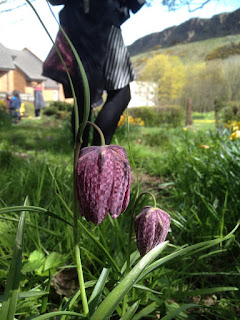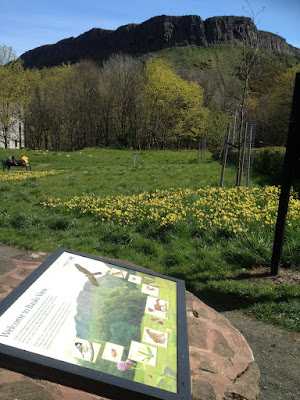This was an event where I brought three of my networks - Wild Reekie, Edinburgh central Eco-Congregations, and Scottish Environment LINK - together in one event, to do something I consider hugely important: to talk to our future political representatives about nature.
 |
| Ben MacPherson, SNP Candidate for Edinburgh Northern and Leith. |
The candidates each had two minutes to give an initial introduction to their policies on nature and biodiversity. They then circulated around the five café tables to discuss the issues with voters in more depth.
This café format was promoted in 2011 by Stop Climate Chaos Scotland, when we ran one at St John's. It is a far better way to get real in-depth conversations going than a traditional platform-format hustings, which is why we adopted it as our chosen method to promote the Wildlife Proclamation.
You can read my guide to hosting a Nature Café here.
 |
| Charles Kennedy, Scottish Conservative candidate for Linlithgow. |
The five candidates, Ben MacPherson (SNP), Charles Kennedy (Scottish Conservative), Hannah Bettsworth (Liberal Democrat), Lorna Slater (Scottish Green) and Richard Corral (Scottish Labour), were given in-depth grillings by each table. But I was very pleased that they agreed it was a much better format: both more probing and less adversarial.
 |
| Hannah Bettsworth, Liberal Democrat candidate for Edinburgh Central. |
Topics discussed included rewilding, land reform, forestry, development, brownfield sites and greenbelt, food production, marine conservation, climate change and natural capital.
 |
| Lorna Slater, Scottish Green candidate for Lothians. |
While the candidates had all clearly done their homework on their parties' own biodiversity policies, there was a great deal of specialist knowledge in the room and numerous left-field questions. It was very encouraging to see the candidates listening as well as speaking, and making notes and exchanging contact details to go and find out about the various issues.
 |
| Wild Reekie members putting Ben MacPherson on the spot. |
This demonstrates, to me, why it is essential for ecologists to engage in politics. We know our society is 'disengaged from nature', and politicians are no more likely than the rest of society to understand the importance of biodiversity. But they are always on the look-out for good policy, and will pay attention to a well-made case for what they should make the next big issue. If they do not act to stop biodiversity decline because no-one has shown them its importance, we have no-one to blame but ourselves.
 |
| Richard Corral, Labour candidate for Lothians. |
My secondary aim for the evening was to ask all the candidates to sign the Scottish Environment LINK Wildlife Proclamation, which reads,
“Scotland’s wildlife, habitats and landscapes are of great importance. Investment in nature, in all its colour, variety and vitality, underpins Scotland’s cultural and economic future and resilience to climate change. If elected I undertake to work to restore Scotland’s nature.”
 |
| Our candidates holding their signed Wildlife Proclamations. |
One might say this is the kind of catch-all statement it is easy for a candidate to sign up to, while pledging little specific in practice. I would disagree for two reasons.
Firstly, explaining to a candidate why they should sign, is to begin that process of showing why biodiversity is so important and so worthy of protection.
Secondly, even if the politician signs and forgets the Wildlife Proclamation, the organisations which make up Scottish Environment LINK will not. All signatories are listed publicly on the
Wildlife Proclamation website, and those who are elected will be held to their pledge in the new parliament, for example by becoming a LINK
Species Champion and engaging in an ongoing process of learning about and working for Scottish biodiversity.
So between now and May, please get involved. Follow the Wildlife Proclamation on
Facebook and
Twitter, explore
wildlifeproclamation.org.uk to order copies of the proclamation, hunt out your candidates at street stalls or hustings and invite them to sign up, and spread the word.
 |
| Ian Gilmour |
Finally, huge thanks to the congregation of St Andrews and St Georges west for letting us use their beautiful church and making it so hospitable, to their minister Ian Gilmour for chairing it and setting a perfect tone of thoughtful discussion, to the St John's Church Green Team for initiating the event and organising the publicity, and to all of you who came, bringing your knowledge of and passion for biodiversity, which made the whole thing possible.
To be kept in touch with future Wild Reekie events, please
join our Meetup group. Follow me on twitter
@eleanormharris.





























